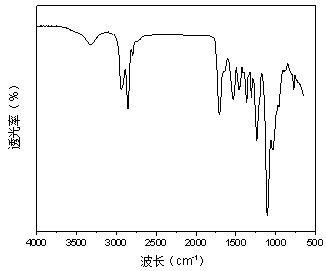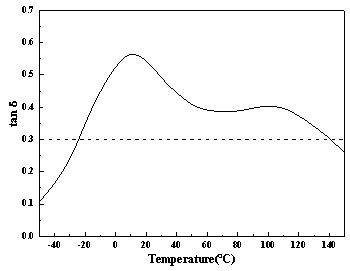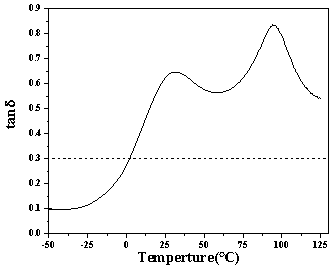Preparation method of water-based polyurethane/acrylate compound emulsion used for damping paint
A water-based polyurethane and acrylate technology, applied in coatings and other directions, can solve the problems of complex process, narrow temperature range of emulsion damping, and use restrictions, and achieve the effect of overcoming high temperature viscous flow and low VOC content
- Summary
- Abstract
- Description
- Claims
- Application Information
AI Technical Summary
Problems solved by technology
Method used
Image
Examples
Embodiment 1
[0039] In a four-necked flask equipped with a stirring device, a condenser, a thermometer and protected by nitrogen, add 40 g of polytetrahydrofuran glycol (number average molecular weight of 2000), vacuum dehydration at 100°C for 1.5 hours, and then add isophor 26g of ketone diisocyanate, 4g of castor oil, 3g of small molecule chain extender 1,4-butanediol, 6g of hydrophilic chain extender dimethylolpropionic acid and 0.1g of catalyst dibutyltin dilaurate. The system is heated to 75 React for 2h at °C, add 5g of hydroxyethyl methacrylate, a blocking agent, and react for 1h.
[0040] The temperature of the system was quickly cooled to 30°C, 70ml of acetone was added to reduce the viscosity, when the -NCO value of the system reached the theoretical value, 4g of salt-forming agent triethylamine was added, the reaction was continued for 10 minutes, and then deionized water was added to adjust the rotation of the stirring device 1000rad / min, emulsify at room temperature for 30min to ...
Embodiment 2
[0045] In a four-necked flask equipped with a stirring device, a condenser, a thermometer and protected by nitrogen, add 40 g of polytetrahydrofuran glycol (number average molecular weight of 2000), vacuum dehydration at 100°C for 1.5 hours, and then add isophor 26g of ketone diisocyanate, 3g of castor oil, 4g of small molecule chain extender 1,4-butanediol, 6g of hydrophilic chain extender dimethylolpropionic acid and 0.1g of catalyst dibutyltin dilaurate. The system is heated to 75 React for 2h at °C, add 4g of hydroxyethyl methacrylate, a blocking agent, and react for 1h.
[0046] The temperature of the system was quickly cooled to 30°C, 70ml of acetone was added to reduce the viscosity, when the -NCO value of the system reached the theoretical value, 4g of salt-forming agent triethylamine was added, the reaction was continued for 10 minutes, and then deionized water was added to adjust the rotation of the stirring device 1000rad / min, emulsify at room temperature for 30min to ...
Embodiment 3
[0050] In a four-necked flask equipped with a stirring device, a condenser, a thermometer and protected by nitrogen, add 20g of polypropylene glycol polyether (number average molecular weight is 1000), vacuum dehydration at 100℃ for 1.5h, and then add toluene diisocyanate 20g, castor oil 5g, small molecule chain extender propylene glycol 4g, hydrophilic chain extender dimethylolpropionic acid 6g, and catalyst dibutyltin dilaurate 0.1g, the system is heated to 75°C for 2h, and end capping agent A is added 5g hydroxyethyl acrylate, react for 1h.
[0051] The temperature of the system was quickly cooled to 30°C, 50ml of acetone was added to reduce the viscosity, when the -NCO value of the system reached the theoretical value, 4g of salt-forming agent triethylamine was added, and the reaction was continued for 10 minutes, and then deionized water was added, and the rotation of the stirring device was adjusted to 1000rad / min, emulsify at room temperature for 30min to obtain an aqueous...
PUM
 Login to View More
Login to View More Abstract
Description
Claims
Application Information
 Login to View More
Login to View More - Generate Ideas
- Intellectual Property
- Life Sciences
- Materials
- Tech Scout
- Unparalleled Data Quality
- Higher Quality Content
- 60% Fewer Hallucinations
Browse by: Latest US Patents, China's latest patents, Technical Efficacy Thesaurus, Application Domain, Technology Topic, Popular Technical Reports.
© 2025 PatSnap. All rights reserved.Legal|Privacy policy|Modern Slavery Act Transparency Statement|Sitemap|About US| Contact US: help@patsnap.com



